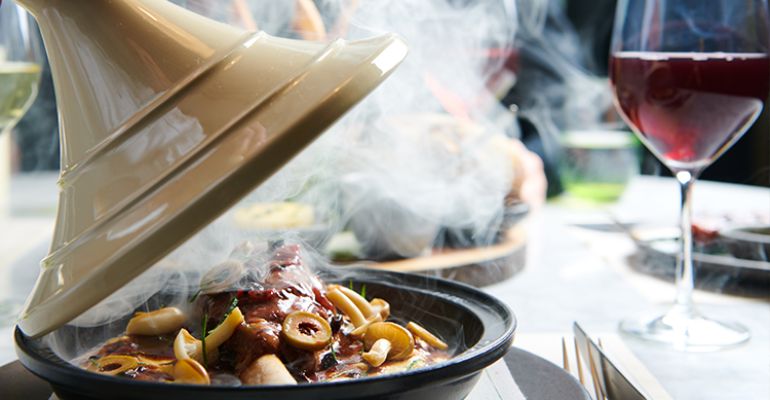Corporate F&B departments are continually refining culinary options onboard to reflect current food trends, while catering to guests’ increasingly sophisticated palates and expectations, all within the realm of what’s possible - and practical - to produce in a shipboard galley. And although recent supply chain logistics have challenged F&B pros, most countered by increasing order lead-times and/or by using acceptable substitutes where necessary.
Despite covering the cruise industry for over 25 years - with a particular focus on cuisine - I’m still suitably impressed by the sector’s fairly recent, rapid acceleration of culinary innovation, notwithstanding the COVID-19 pause. Healthy competition, naturally, has played a part in this evolution, but trends, talent and money also weigh heavily, with the single, overarching trend being the companies’ propensity to punch above their weight, i.e., propel their onboard products into the next niche. Based on several recent sailings, and with the benefit of history as context, I’ve identified what a few leading industry players in all segments - from contemporary to luxury - are cooking up in order to provide healthy, innovative and gourmet dishes for their guests.
Budget + Italian Influence Push Dining Into Premium Territory on MSC
With fast-growing MSC Cruises’ laser-like focus on aggressively gaining market share in North America, the line’s U.S.-based ships feature an impressive and interesting array of quality dishes that often exceed expectations in the value-driven, contemporary market. That literal recipe for success stems from the influence of MSC’s Italian heritage - which is reflected in slightly more adventurous culinary options than North American guests are usually treated to - and is further enhanced by what is obviously a commensurately larger F&B budget than is typical in the line’s competitive set. In fact, menus on MSC’s U.S.-based vessels skew more towards the premium category with copious amounts of shellfish, gourmet pastas and complex pastries offered in the base-fare restaurants.
The addition of the company’s luxury, ship-within-a-ship product, MSC Yacht Club, further ratchets up the culinary experience with a dedicated restaurant and pool area serving elevated cuisine. But perhaps most impressive here is the Yacht Club’s Top Sail Lounge, which offers five, rotating culinary presentations between 6:00 a.m. and 1:00 a.m. displaying gourmet savories and sweets like luscious - and otherwise expensive - Venchi chocolates.

HAL Leads the Way in the Rise of the Lido Buffet
While celebrity-chef partnerships have become ubiquitous in the industry, Holland America Line’s (HAL) tack in this realm is less about the celebrity - and more about the actual talent. Under the guidance of uber-talented Master Chef Rudi Sodamin, HAL’s Culinary Council of chefs use their recipe expertise and top-notch provisions to develop the quality dishes deployed across all shipboard venues, from casual to fine dining.
And the line’s Lido Market concept is testament to the belief that casual, buffet dining - an iconic, cruise ship staple - needn’t be an afterthought. Rather, it’s a lateral-quality dining option on HAL that frequently reaches into gourmet territory. I’ve watched its continual evolution as a barometer of what’s trending, healthy and popular. “Healthy Corner” at the Lido Market breakfast finds a wide array of berries, nuts, dried fruits and seeds that sophisticated guests expect with their unsweetened Greek yogurt, while the lunchtime “Wild Harvest” salad station offers seared ahi tuna and fresh roasted turkey in made-to-order salads. All food is prepared at Lido Market’s myriad action stations, which feature individually-plated dishes or crew service, thus reducing waste and ensuring freshness. Dinner here is typically a reflection of the main dining room fare - at the same quality level.

Oceania’s Mission: Catering to Foodie Obsessions
If Oceania’s mission statement could be summed up succinctly, it very well could be “Catering to Foodie Desires - One Dish at a Time.” As the upper-premium line’s epicurean ethos powers on to deliver on its ballsy marketing tagline, “The Finest Cuisine at Sea,” guests onboard the company’s boutique ships encounter a bounty of quality choices on menus that are longer than some novels. In fact, the intersection of quantity and quality is what makes Oceania’s culinary operation unique in the industry. The line’s symbiotic relationship with the Apollo Group ensures that a large, talented pool of corporate chefs travel the world for inspiration and sail frequently, thus ensuring quality control and fleet standardization.
Just prior to the COVID-19 pause, Oceania introduced over 200 new, plant-based dishes across casual and fine dining venues. I was particularly impressed with a Papaya Kelp Noodle Salad followed by a surprisingly decadent dessert: Vodka-Marinated Strawberries Romanoff with Plant-Based Vanilla Ice Cream.

Seabourn Takes Alternative Dining Outside the Box - Literally
While lines in every cruise sector now offer myriad dining options - unfortunately too often bolstered by extra-charge, mediocre-quality specialty restaurants - the luxury end of the business suffers most from performance anxiety in this realm. These upscale eateries (included in the fare, of course) must all operate on point, as their sophisticated, upmarket clientele demand a top-quality product - and have the chops to critique it.
So it wasn’t enough that Seabourn’s guests could choose from The Restaurant’s modern French cuisine, The Colonnade’s casual-yet-gourmet fare or The Grill by Thomas Keller (the touchstone for Chef Keller groupies). Taking advantage of an under-utililzed, poolside venue in the evening, “Earth & Ocean at the Patio” presents an unusually complex set of dishes amid a candlelit ambiance.
In a concept developed by consulting chef Anton Egger, Earth & Ocean features creative and sophisticated dishes inspired by far-flung locales, delivered via interesting service elements (think: smoke boxes, ceramic Moroccan tagines) not typically seen poolside. And in a juxtaposition that was pure Seabourn, I finished my meal with warm, slow-roasted, Costa Rican pineapple accompanied by a scoop of Italian gelato - while bundled up against the cold in a chilly Norwegian fjord.


